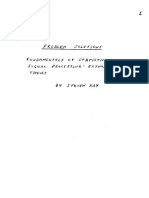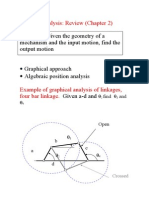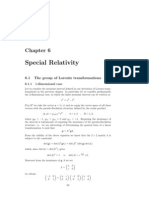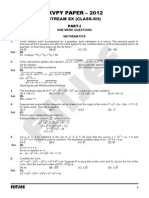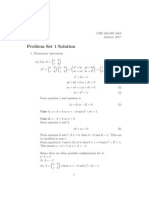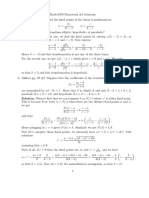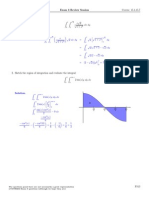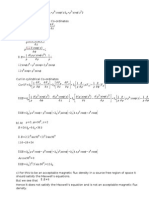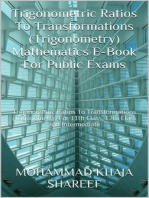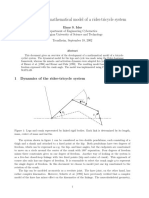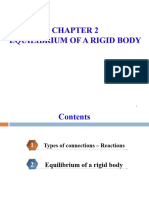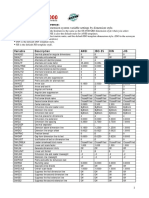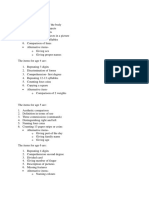6.641 Electromagnetic Fields, Forces, and Motion: Mit Opencourseware
6.641 Electromagnetic Fields, Forces, and Motion: Mit Opencourseware
Uploaded by
Ahmed AiadCopyright:
Available Formats
6.641 Electromagnetic Fields, Forces, and Motion: Mit Opencourseware
6.641 Electromagnetic Fields, Forces, and Motion: Mit Opencourseware
Uploaded by
Ahmed AiadOriginal Title
Copyright
Available Formats
Share this document
Did you find this document useful?
Is this content inappropriate?
Copyright:
Available Formats
6.641 Electromagnetic Fields, Forces, and Motion: Mit Opencourseware
6.641 Electromagnetic Fields, Forces, and Motion: Mit Opencourseware
Uploaded by
Ahmed AiadCopyright:
Available Formats
MIT OpenCourseWare
http://ocw.mit.edu
6.641 Electromagnetic Fields, Forces, and Motion
Spring 2005
For information about citing these materials or our Terms of Use, visit: http://ocw.mit.edu/terms.
6.641 Electromagnetic Fields, Forces, and Motion Spring 2005
Problem Set 1 - Solutions
Prof. Markus Zahn MIT OpenCourseWare
Problem 1.1
A
F = q(E + v B) Lorentz Force Law
In the steady state F = 0, so
q E = q v B E = v B
v
y
i
y
pos. charge carriers
v =
v
y
i
y
neg. charge carriers
B = B
0
i
z
so
v B
y 0
i
x
pos. charge carriers
E =
v
y
B
0
i
x
neg. charge carriers
B
d 0
v
H
= (x = d) (x = 0) =
E
x
dx =
E
x
dx
0 d
v
y
B
0
d pos. charges
v
H
=
v
y
B
0
d neg. charges
C
As seen in part (b), positive and negative charge carriers give opposite polarity voltages, so answer is yes.
Problem 1.2
By problem:
b
r < b
=
a
b < r < a
Also, no
s
at r = b, but nonzero
s
at r = a such that E = 0 for r > a.
1
Problem Set 1 6.641, Spring 2005
v
E
-
+ +
+
- +
-
+
+
- +
B
Force caused
Force
by E
caused
+ -
-
- -
by B
+ -
+ -
+
v
E
Force caused by E
Force caused
(which is caused by
by B
charge on electrodes)
Figure 1: Figure for 1C. Opposite polarity voltages between holes and electrons (Image by MIT OpenCourse-
Ware.)
A
By Gausss Law
0
E d a = dV S
R
= sphere with radius r (1)
S
R
V
R
As shown in class, symmetry ensures E has only radial component: E = E
r
i
r
.
LHS of (1):
0
E d
a =
0
(E
r
i
r
) r
2
sin dd
i
r
S
R
0 0
a in spherical coordinates
= 4r
2
E
r
0
surface area of sphere of radius r
RHS of (1):
For r < b:
r
2
dV =
b
r
2
sin dddr
V
R
0 0 0
dV : di vol. element
4
= r
3
b
3
vol of sphere
For r > b and r < a: (b < r < a):
b
2
dV =
b
r
2
sin dddr
V
R
0 0 0
r
2
+
a
r
2
sin dddr
b 0 0
4
b
b
3
4
a
(r
3
b
3
)
= +
3 3
2
Problem Set 1 6.641, Spring 2005
Equating LHS and RHS:
4r
3
r < b
4r
2
E
3
b
r
0
=
4
b
b
3
4
+
a
(r
3
b
3
)
b < r < a
3 3
r
b
r < b
E
r
=
3
0
b
3
(
b
a
)
a
r
b < r < a
3
0
r
2
+
3
0
B
Again: n (
0
E
a
0
E
b
) =
s
E(r = a
+
) = 0
)
E
b
3
(
b
a
a
a
(r = a ) = + +
i
r
by part (a)
3
0
a
2
3
0
s
=
i
r
(
0
E(r = a
))
so
b
3
( ) a
s
=
b a a
+
3a
2
3
C
4
r < b Q = b
3
b
Q
(r = a) =
2
b s
4a
3
4
b < r < a Q
a
= (a
3
b
3
)
a
3
Q
T
= Q
b
+ Q
a
+ Q
= 0
Problem 1.3
a
We are told current going in +z direction inside cylinder r < b. Current going through cylinder
= I
total
=
J d a
S
b
2
= (J
0
i
z
) rddri
z
)
0 0
J
= J
0
b
2
d
a
Total current in sheet
|K| =
length of sheet (i.e. circumference of circle of radius a)
Thus,
A
Ks units are
mps Amps
J
m
, whereas s units are
m
2
J
0
b
2
J
0
b
2
|K| = =
2a 2a
J
0
b
2
K =
i
z
2a
3
Problem Set 1 6.641, Spring 2005
Figure 2: Figure for Problem 1.3 Part A. A cylinder with volume current going in the +z direction for r < b.
(Image by MIT OpenCourseWare)
B
_
_
d
H d s = J d a +
C S
_
0
E d a
dt
.
S
(2)
no E eld, so this term is 0
Choose C as a circle and S as the minimum surfa
.
ce that circle bounds. Now, solve LHS of Amperes Law
3
z
a b
b
z
a
s c
Figure 3: Choice of contour C and surface S (Image by MIT OpenCourseWare).
(2)
_
2
H d s =
C
_
0
_
H
_
.
H
_
rd
_
. .
= 2rH
We assumed H
z
= H
r
= 0. This follows fr
.
om the symmetry of the problem. H
r
= 0 because
0
Hd a = 0.
S
In particular, choose S as shown in Figure 3. H
z
is more dicult to see. It is discussed in Haus & Melcher.
The basic idea is to use the contour, C, to show that if H
z
= 0 it would have to be non
_
zero even at ,
which is not possible without sources at . Now for RHS of Ampere:
r < b :
4
Problem Set 1 6.641, Spring 2005
z
b
c
Figure 4: Illustration of the contour C (Image by MIT OpenCourseWare).
b
s
Figure 5: Diagram showing surface S (Image by MIT OpenCourseWare).
2
r
J d
a = J
0
i
z
r dr d
i
z
S 0 0
J
d
a
= J
0
r
2
a > r > b :
2
b
2
r
J d
a = (J
0
i
z
) (r dr d
i
z
+ (0
i
z
) (r dr d
i
z
)
S 0 0 0 b
0
= J
0
b
2
Equating LHS and RHS:
J
0
r
2
r < b
2rH
=
J
0
b
2
a > r > b
J
0
r
i
r < b
H =
2
J
0
b
2
i
a > r > b
2r
From text, Amperes continuity condition:
n (H
a
H
b
) = K
5
C
Problem Set 1 6.641, Spring 2005
region
(a>r>b)
a
b
z
region
(r>a)
region
(b>r)
Figure 6: Amperes continuity condition for Problem 1.3 Part C (Image by MIT OpenCourseWare)
H
(r = a
) = K
z
J
0
b
2
J
0
b
2
= K
z
=
2a 2a
Problem 1.4
A
We can simply add the elds of the two point charges. Start with the eld of a point charge q at origin and
let S
R
be sphere of radius R centered at the origin. By Gauss:
0
E d a = dV
S
R
In this case = (
r )q, so RHS is
dV = (
r )qdxdydz = q
LHS is
0
E
r
d a = (
0
E
r
)(surface area of S
r
)
S
R
symmetry again
= 4r
2
0
E
r
Equate LHS and RHS
4r
2
0
E
r
= q
q
E =
i
r
4r
2
0
Convert to cartesian: Any point is given by
r = x(r, , )
i
x
+ y(r, , )
i
y
+ z(r, , )
i
z
By spherical coordinates
x = r sin cos
y = r sin sin
6
Problem Set 1
z = r cos
r = r sin cos
i
x
+ r sin sin
i
y
+ r cos
i
z
i
r
line formed by varying r and xing and
r = ri
r
Thus,
i
r
= sin cos i
x
+sin sin
i
y
+cos
i
z
x y z
= i
x
+ i
y
+ i
z
x
2
+ y
2
+ z
2
x
2
+ y
2
+ z
2
x
2
+ y
2
+ z
2
so,
q
E =
i
r
4
0
(x
2
+ y
2
+ z
2
)
E
total
= E
1
+ E
2
E
1
is just E with y y
d
. E
2
is just E with y y +
d
. Problem has y
2 2
(i)
d
z
E
2
total
= E
1
=
i
x
+
d
i
z
d
2
x
2
+
2
+ z
2
x
2
+ + z
2
x
2
+
d
2
+ z
4 4 4
q
=
3
d
2
x
i
x
i + z
y
i
z
4
d
0
(x
2
+ + z
2
)
2 2
4
6.641, Spring 2005
= 0
q
i
y
2
+
d
2
2
) 2 4
0
(x + z
4
(ii)
E
total
= E
1
+ E
2
x
i
x
+ z
i
z
= q
2
0
(x
2
+
d
2
2
+ z
2
)
(iii)
E
total
= E
1
+ E
2
dq
i
y
=
3
2
4
0
x
2
+
d
4
2
2
+ z
B
3
2
F = q
1
E E doesnt include eld of q
(i)
F = 0, by Newtons third law a body cannot exert a net force on itself.
(ii)
d
F = q
1
E = q E
2
(x = 0, y = , z = 0)
2
q
2
i
y
q
2
i
y
= =
4
0
(d
2
) 4
0
d
2
(iii)
q
2
i
y
F =
4
0
d
2
7
You might also like
- Solutions Manual - Fundamentals of Statistical Signal Procession - Estimation Theory-Stephen-KayDocument221 pagesSolutions Manual - Fundamentals of Statistical Signal Procession - Estimation Theory-Stephen-KayShakil Ahmed Chowdhury80% (10)
- FE Math PracticeDocument8 pagesFE Math PracticeAdam Wilkins71% (7)
- Sol03 Landau LevelsDocument8 pagesSol03 Landau LevelsPrashant SharmaNo ratings yet
- HW4 SolutionsDocument7 pagesHW4 SolutionserfanghlmNo ratings yet
- Essential Formulae: Number and AlgebraDocument7 pagesEssential Formulae: Number and AlgebraShinigami01001No ratings yet
- EMT by Jakson PDFDocument145 pagesEMT by Jakson PDFSafi Ullah KhanNo ratings yet
- Chap 1 and 2Document7 pagesChap 1 and 2ismaeil1365No ratings yet
- Math 317 - Assignment #6 (Solutions)Document4 pagesMath 317 - Assignment #6 (Solutions)wenderdoodleNo ratings yet
- Lec 32Document8 pagesLec 32raw.junkNo ratings yet
- Electrostatic ExamplesDocument36 pagesElectrostatic ExamplesdiptodevilNo ratings yet
- Math Formulas For Class XDocument6 pagesMath Formulas For Class Xravilakra lakraNo ratings yet
- Sol 4 Fall 04Document12 pagesSol 4 Fall 04Daniel Cervantes CabreraNo ratings yet
- 6.641 Electromagnetic Fields, Forces, and Motion : Mit OpencoursewareDocument5 pages6.641 Electromagnetic Fields, Forces, and Motion : Mit OpencoursewareRichard JoserNo ratings yet
- Outline of Solutions To Homework 1Document3 pagesOutline of Solutions To Homework 1Michel AndradeNo ratings yet
- 50999882VAKX - Electromagnetic Field Theory - Solution ManualDocument212 pages50999882VAKX - Electromagnetic Field Theory - Solution ManualAnney Revathi50% (4)
- Math 121A: Midterm 1 Solutions: AnswerDocument5 pagesMath 121A: Midterm 1 Solutions: AnswercfisicasterNo ratings yet
- QuarticDocument10 pagesQuarticlalasoisNo ratings yet
- Problem 4.5 (A) (B) (C) (D)Document11 pagesProblem 4.5 (A) (B) (C) (D)Steve HoNo ratings yet
- Appendix D Basic Basic Engineering Engineering Calculations CalculationsDocument25 pagesAppendix D Basic Basic Engineering Engineering Calculations CalculationsaakashtrivediNo ratings yet
- Math AppDocument7 pagesMath Appg3dizeNo ratings yet
- Gu Ia de Problemas de La Secci On 2.5 Del Libro Mathematical Methods For Physicists, Sixth Edition, de George ArfkenDocument8 pagesGu Ia de Problemas de La Secci On 2.5 Del Libro Mathematical Methods For Physicists, Sixth Edition, de George ArfkenSergio AguilarNo ratings yet
- Homework Assignment 5 Solution Set: PHYCS 4420 23 February, 2004Document8 pagesHomework Assignment 5 Solution Set: PHYCS 4420 23 February, 2004Jose Alejandro JovelNo ratings yet
- Jackson Electrodynamics, Notes 1Document5 pagesJackson Electrodynamics, Notes 1Tianyi ZhangNo ratings yet
- Position Analysis ReviewDocument14 pagesPosition Analysis ReviewBharani DaranNo ratings yet
- 6.electromagnetic waves-MCQ-MSQ-NAT - SolutionDocument4 pages6.electromagnetic waves-MCQ-MSQ-NAT - SolutionTiffany WatkinsNo ratings yet
- Problem Set 1Document9 pagesProblem Set 1belderandover09No ratings yet
- SAT Subject Math Level 2 FactsDocument11 pagesSAT Subject Math Level 2 FactsSalvadorNo ratings yet
- Quiz 2 SolutionsDocument21 pagesQuiz 2 SolutionsTom smithNo ratings yet
- 320 Chapter 5Document6 pages320 Chapter 5gusgaraNo ratings yet
- AE321 - Solutions For Homework 9: F F F GDocument13 pagesAE321 - Solutions For Homework 9: F F F GArthur Ding100% (1)
- Special Relativity: 6.1 The Group of Lorentz TransformationsDocument10 pagesSpecial Relativity: 6.1 The Group of Lorentz Transformationsfree_progNo ratings yet
- 2012 PaperDocument25 pages2012 PaperTanmay ShuklaNo ratings yet
- V V π 2 1 V π 2 V π 2Document3 pagesV V π 2 1 V π 2 V π 2jisteeleNo ratings yet
- Physics 139A Homework 1: 1 Problem 1.1Document10 pagesPhysics 139A Homework 1: 1 Problem 1.1a2618765No ratings yet
- PS1 Solution 2Document16 pagesPS1 Solution 2Achilles TrojansNo ratings yet
- The Method of Frobenius PDFDocument25 pagesThe Method of Frobenius PDFanon_928952887No ratings yet
- Solutions For Model Grand Test:: Paper - 1: K 1 LN K K KDocument9 pagesSolutions For Model Grand Test:: Paper - 1: K 1 LN K K KSayan Kumar KhanNo ratings yet
- Formulari OpticaDocument2 pagesFormulari OpticaJonnathan Sanchez PalominoNo ratings yet
- 2nd Sem Apr 2022Document12 pages2nd Sem Apr 2022rukkiya253No ratings yet
- ConstantsDocument23 pagesConstantsJohn JohnNo ratings yet
- D Integral 2Document8 pagesD Integral 2xzNo ratings yet
- Homework 1 Solutions: 1 Jackson 1.3Document5 pagesHomework 1 Solutions: 1 Jackson 1.3ahsanqauNo ratings yet
- Quantifier Elimination Optimal Solution For Two Classical Examples-Daniel LazardDocument6 pagesQuantifier Elimination Optimal Solution For Two Classical Examples-Daniel Lazardmorteza90No ratings yet
- Static and Spherically Symmetric Solutions in A Scenario With Quadratic Curvature ContributionDocument16 pagesStatic and Spherically Symmetric Solutions in A Scenario With Quadratic Curvature ContributionCroco Ali0% (1)
- Lab9 BeamLabSolDocument8 pagesLab9 BeamLabSolPatrick LeeNo ratings yet
- Quantum Mechanics. Homework II.: Alfredo Vidal Arias May 6, 2014Document3 pagesQuantum Mechanics. Homework II.: Alfredo Vidal Arias May 6, 2014dajksbeiNo ratings yet
- MAT 342 Applied Complex Analysis Midterm 2: Z X X ZDocument3 pagesMAT 342 Applied Complex Analysis Midterm 2: Z X X ZJuwandaNo ratings yet
- Maths QP Ans CET-2013Document9 pagesMaths QP Ans CET-2013pacesoft3210% (1)
- Double IntegrationDocument22 pagesDouble IntegrationIvan Hernandez100% (1)
- Homework 4 SolDocument6 pagesHomework 4 SoljanroxaNo ratings yet
- MTH 234 Exam Review 3 SolutionsDocument11 pagesMTH 234 Exam Review 3 SolutionsDonald ChurchNo ratings yet
- Section A3.4: Power Series SolutionDocument7 pagesSection A3.4: Power Series SolutionAdzar JumaaniNo ratings yet
- WBJEE 2014 Mathematics Question Paper With SolutionsDocument20 pagesWBJEE 2014 Mathematics Question Paper With SolutionsLokesh Kumar0% (2)
- PHYS1314 Spring 2015 Solution of Homework 2Document5 pagesPHYS1314 Spring 2015 Solution of Homework 2AuHoPangNo ratings yet
- Laplace Eqn Cartesian CoordsDocument9 pagesLaplace Eqn Cartesian CoordsJoni PhamNo ratings yet
- Quantum Mechanics NET-JRF June 2011 - June 2014Document32 pagesQuantum Mechanics NET-JRF June 2011 - June 2014Abhishek UpadhyayNo ratings yet
- Engineering Electrodynamics MidtermDocument36 pagesEngineering Electrodynamics MidtermSrinivas PrasadNo ratings yet
- GATE Mathematics Paper-2003Document13 pagesGATE Mathematics Paper-2003RajkumarNo ratings yet
- Trigonometric Ratios to Transformations (Trigonometry) Mathematics E-Book For Public ExamsFrom EverandTrigonometric Ratios to Transformations (Trigonometry) Mathematics E-Book For Public ExamsRating: 5 out of 5 stars5/5 (1)
- De Moiver's Theorem (Trigonometry) Mathematics Question BankFrom EverandDe Moiver's Theorem (Trigonometry) Mathematics Question BankNo ratings yet
- Jee Mains 2012-1 QuestionsDocument43 pagesJee Mains 2012-1 QuestionsJanaki KrishnanNo ratings yet
- Exception Handling in JavaDocument34 pagesException Handling in JavaNavdeep WaliaNo ratings yet
- Stat Prob PTDocument2 pagesStat Prob PTJade ivan parrochaNo ratings yet
- On Stochastic Model in InsuranceDocument20 pagesOn Stochastic Model in Insurancedaniel vargasNo ratings yet
- Matrices1 PDFDocument8 pagesMatrices1 PDFMansoor KhanNo ratings yet
- Ntroduction To Finite Element Vibration Analysis, Maurice Petyt PDFDocument574 pagesNtroduction To Finite Element Vibration Analysis, Maurice Petyt PDFOmar VelasquezNo ratings yet
- Lacture 6Document44 pagesLacture 6Ali KhanNo ratings yet
- Format SpecifierDocument3 pagesFormat Specifierajwa telNo ratings yet
- Review Mathematical WizardryDocument3 pagesReview Mathematical Wizardryduyhoa83No ratings yet
- CV Jay Goel IITRPRDocument1 pageCV Jay Goel IITRPRAshutosh KumarNo ratings yet
- Chemical Reactor CSTRDocument88 pagesChemical Reactor CSTRErwin_SchNo ratings yet
- Local - PCA - It Is Against PCADocument24 pagesLocal - PCA - It Is Against PCAdr musafirNo ratings yet
- Lds 01 B1 PDFDocument6 pagesLds 01 B1 PDFMihai LazărNo ratings yet
- Module 3Document55 pagesModule 3vaishnavirai273No ratings yet
- Math9 LAS Q4 W3Document7 pagesMath9 LAS Q4 W3Jay PeeNo ratings yet
- In-Depth Investigation of The Validity of The Archie Equation in Carbonate RocksDocument10 pagesIn-Depth Investigation of The Validity of The Archie Equation in Carbonate Rocksbrg268No ratings yet
- A Level Computing 9691 Paper 2 NotesDocument85 pagesA Level Computing 9691 Paper 2 NotesNash Ash Sh100% (1)
- Java 5 TigerDocument17 pagesJava 5 TigersandeepveersNo ratings yet
- Macro&Micro2011 Author PDFDocument25 pagesMacro&Micro2011 Author PDFAbdul jeleelNo ratings yet
- Development of A Mathematical Model of A Rider-Tricycle SystemDocument7 pagesDevelopment of A Mathematical Model of A Rider-Tricycle Systemglazy BrianNo ratings yet
- Min Cost 2Document9 pagesMin Cost 2SHAMEEK PATHAKNo ratings yet
- Simulation Modeling and Analysis With ArenaDocument64 pagesSimulation Modeling and Analysis With ArenaCristiam Hernandez MarloNo ratings yet
- Chapter 2 CHCSDocument153 pagesChapter 2 CHCS23149232No ratings yet
- E103 - AgustinDocument20 pagesE103 - AgustinSeth Jarl G. AgustinNo ratings yet
- AutoCAD 2000 Dimension System VariablesDocument5 pagesAutoCAD 2000 Dimension System VariablesariostojrNo ratings yet
- 2023 Exam SpecificationsDocument29 pages2023 Exam SpecificationsAnumNo ratings yet
- 1 s2.0 0141029695000345 MainDocument16 pages1 s2.0 0141029695000345 MainArjun Kisan ShendeNo ratings yet
- RC ChargingDocument6 pagesRC ChargingkaushalNo ratings yet
- BKT ITEMSDocument3 pagesBKT ITEMSHG22No ratings yet
